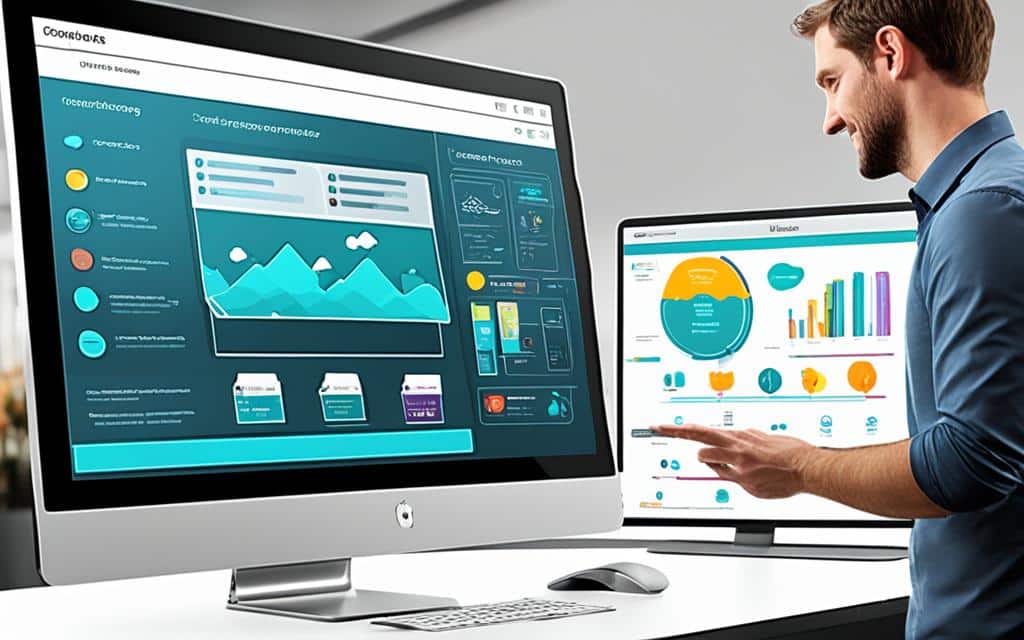Table of Contents
Welcome to our blog post on personalization in interactive design. In today’s digital landscape, user experiences play a vital role in capturing and retaining audience attention. Personalization has emerged as a powerful tool in creating tailored user experiences encompassing the individual user’s needs, preferences, and behavior. It involves techniques such as tracking user behavior, collecting user data, and utilizing machine learning algorithms to adapt interfaces to the user.
At its core, personalization in interactive design aims to optimize user experiences by offering content, features, and recommendations that resonate with each user on a personal level. By catering to their unique requirements, personalization enhances user engagement and satisfaction, ultimately leading to a stronger connection between users and digital platforms.
This article explores the evolution of personalization in interaction design and the various types of personalization used in UI/UX design. We will delve into the importance of personalization in creating immersive user experiences and discuss the essential elements necessary for implementing personalization effectively. Finally, we will touch upon the need for responsible design practices and the future of personalization in UI/UX design.
Stay tuned as we take you through this exciting journey into the world of personalization in interactive design.
The Evolution of Personalization in Interaction Design
Over the years, technology advancements have unlocked new opportunities for personalization in interaction design. Once upon a time, digital experiences were static, but with the advent of cookies, websites could remember user preferences and show personalized content. The rise of AI and machine learning further enhanced personalization by allowing for tailored content, adaptable interfaces, and detailed insights. Today, generative AI is taking personalization to new levels by predicting user needs and preferences in the future based on extensive data analysis and understanding of natural language.
The evolution of personalization in interaction design has brought about significant changes in user experiences. The ability to deliver customized content and adapt interfaces to individual users has revolutionized the way we interact with technology. By leveraging technology advancements, designers can create interactive experiences that resonate with users on a personal level.
One of the key advancements in personalization is the use of AI and machine learning algorithms. These technologies enable the design of interfaces that can learn from user behavior, adapt to their preferences, and provide relevant and timely content. AI and machine learning algorithms can analyze vast amounts of data to uncover patterns and insights that help improve personalization strategies.
Furthermore, customization has become a core aspect of personalization in interaction design. Users now expect interfaces that can be tailored to their individual needs and preferences. Customization allows users to have control over their digital experiences, empowering them to personalize interfaces according to their own preferences. This not only enhances user satisfaction but also fosters a sense of ownership and connection with the technology.
The advancements in personalization have also paved the way for more intuitive and adaptive interfaces. Interfaces can now anticipate user needs and adapt in real-time, providing a seamless and personalized user experience. This level of adaptability allows users to effortlessly navigate through interfaces, resulting in increased efficiency and satisfaction.
As personalization continues to evolve, designers need to stay up-to-date with the latest trends and technologies in order to create impactful interactions. By embracing AI, machine learning, and customization, designers can elevate the user experience, foster engagement, and create meaningful connections between users and technology.
Types of Personalization in UI/UX Design
Personalization in UI/UX design offers various types of customization to enhance the user experience. By tailoring interfaces to specific user segments, websites can provide more relevant and engaging content. Let’s explore the different types of personalization in UI/UX design:
1. User Segments
Dividing users into segments based on traits allows for customized content delivery. By understanding user preferences, interests, and behavior, designers can create tailored experiences that cater to specific user groups. This personalization approach ensures that users receive content that aligns with their individual preferences and increases engagement.
2. Content Customization
UI/UX design can be personalized by customizing the content presented to users. By offering options for users to adjust their preferences and select their interests, websites can provide content that is personalized to their needs. This customization allows for a more individualized experience and promotes user satisfaction.
3. Location-based Personalization
Location-based personalization involves tailoring UI/UX design based on the user’s geographic location. By capturing location data, websites can provide localized content, recommendations, and user interfaces that are relevant to the user’s location. This type of personalization creates a more connected and contextually rich user experience.
4. User Roles
UI/UX design can also be personalized by assigning user-defined roles. By allowing users to define their roles within an application or website, designers can tailor the UI to align with the specific tasks and goals of each user. This personalization ensures that users have an optimized experience that caters to their unique roles.
5. Time-based Personalization
Personalization based on time allows for the adaptation of UI/UX design depending on the time of the day or specific events. By considering factors such as time zones or special occasions, websites can display content that is timely and relevant. This type of personalization enhances the user experience by providing information and features when users need them most.
6. Recommendation Systems
Recommendation systems play a significant role in personalization. By analyzing user behavior and preferences, these systems provide personalized suggestions and recommendations. These recommendations can include content, products, or features that align with the user’s interests. Recommendation systems enhance the user experience by offering personalized options that match the user’s preferences, increasing engagement and satisfaction.
“Personalization in UI/UX design offers diverse ways to create tailored user experiences, engaging different user segments, and catering to their specific needs and preferences.”
Now that we have explored the different types of personalization in UI/UX design, we can see how these approaches enable a more tailored and engaging user experience. By implementing personalization techniques such as user segments, content customization, location-based personalization, user roles, time-based personalization, and recommendation systems, designers can create interfaces that resonate with users and enhance their overall satisfaction.
At a glance, here’s a summary of the types of personalization in UI/UX design:
| Types of Personalization | Description |
|---|---|
| User Segments | Dividing users based on traits to deliver customized content. |
| Content Customization | Allowing users to personalize their content preferences. |
| Location-based Personalization | Tailoring UI/UX design based on the user’s geographic location. |
| User Roles | Adapting the UI to align with user-defined roles. |
| Time-based Personalization | Adjusting UI/UX design based on the time of the day or specific events. |
| Recommendation Systems | Providing personalized suggestions based on user behavior and preferences. |
By understanding and implementing these types of personalization, designers can create UI/UX designs that foster a stronger connection with users, deliver content that resonates, and provide tailored experiences that enhance engagement and satisfaction.
The Importance of Personalization in UI/UX Design
Personalization plays a crucial role in UI/UX design as it enhances the user experience by creating a design that is customized to each individual user. By understanding their interests and preferences, personalization helps to create a stronger connection with users and increases user engagement.
When a design is personalized, it makes the user feel valued and understood. It shows that the design considers their unique needs and provides relevant content, features, and recommendations that align with their interests. This level of personalization cultivates a sense of connection between the user and the design, fostering a deeper engagement and creating a positive user experience.
“Personalization helps designers build a bridge between their design and the user, fostering a sense of connection and understanding.”
Imagine visiting a website that remembers your previous interactions, displays products or services that align with your preferences, and offers personalized recommendations based on your browsing history. This level of personalization not only saves time but also makes the user feel like the design is tailored specifically for them. This personalized experience leads to a more fulfilling and satisfying user journey.
The Impact of Personalization on User Engagement
Personalization significantly influences user engagement. When a design is personalized, it captures the user’s attention and encourages them to explore further. By providing customized content and recommendations, personalization creates a user experience that feels relevant, valuable, and curated. This, in turn, motivates users to actively engage with the design, increasing their time spent on the platform and their likelihood of returning.
Furthermore, personalized designs improve user satisfaction and loyalty. When users feel seen and understood through personalized experiences, they are more likely to develop a sense of trust and loyalty towards the brand or platform. This cultivates a long-lasting connection, increasing user retention and advocacy.
Creating a Personalized User Experience
To create an effective personalization strategy in UI/UX design, designers need to employ various techniques. This includes gathering user data through surveys, user feedback, and behavior tracking. By analyzing this data, designers can gain valuable insights into user preferences, interests, and behavior patterns, enabling them to deliver a more personalized user experience.
Designers can also utilize machine learning algorithms to automate the personalization process. These algorithms can analyze large amounts of user data to generate personalized recommendations, content, and tailored interfaces. By integrating intelligent algorithms into the design process, designers can create dynamic designs that adapt and evolve with each user interaction.
Visualizing the Importance of Personalization
Take a look at the infographic below that highlights the importance of personalization in UI/UX design:
As the infographic illustrates, personalization in UI/UX design leads to enhanced user experiences, increased user engagement, improved conversion rates, and stronger brand loyalty. By understanding the significance of personalization, designers can unlock the full potential of their designs and create impactful user experiences.
In conclusion, personalization is not just a trendy concept in UI/UX design—it is a fundamental aspect that holds the power to transform the way users interact with digital platforms. By tailoring designs to individual users, designers can create experiences that resonate, engage, and ultimately leave a lasting impression.
Essential Elements of Personalization in UI/UX Design
To implement effective personalization in UI/UX design, several key elements must be taken into consideration. These elements play a crucial role in tailoring the user experience to meet the individual needs and preferences of the target audience.
Identifying the Target Audience
One of the fundamental elements of personalization is understanding the target audience. By conducting thorough research and analysis, designers can gain insights into the interests, behaviors, and demographics of the users. This knowledge is invaluable in creating a design that resonates with the intended audience, ultimately leading to higher engagement and satisfaction.
Clear Goals for the Design
Setting clear goals is essential in achieving effective personalization in UI/UX design. By defining the objectives of the design, designers can align their efforts with the desired outcomes. Whether the goal is to increase conversion rates, improve user engagement, or enhance brand loyalty, having specific goals enables designers to make informed decisions that support personalization efforts.
Utilizing Push Notifications
Push notifications are a powerful tool in engaging users and delivering personalized content. By leveraging the capabilities of push notifications, designers can proactively communicate with users and provide relevant information based on their preferences and interactions. Whether it’s notifying users about new features, updates, or personalized recommendations, push notifications create opportunities for meaningful and personalized interactions.
Leveraging Geolocation for Personalized Content
Geolocation is another crucial element in UI/UX design personalization. By utilizing location data, designers can deliver content that is relevant to the user’s physical context. This can include tailored recommendations, location-based discounts, or localized information. Geolocation-based personalization enhances the user experience by providing content that is specific to the user’s location, increasing the perceived value and relevance of the design.
Allowing Users to Resume from Last Visited Area
A seamless user experience is vital for personalization in UI/UX design. Allowing users to resume from their last visited area enhances engagement and convenience. By remembering the user’s progress or preferences, the design can pick up where the user left off, creating a sense of continuity and personalization. This feature is particularly valuable for applications that involve multiple sessions or tasks, such as e-commerce platforms, productivity tools, or learning platforms.
By incorporating these essential elements of personalization in UI/UX design, designers can create user experiences that are tailored to the individual needs and preferences of the target audience. From understanding the target audience to leveraging geolocation and push notifications, personalization enhances engagement, satisfaction, and the overall success of the design.
Conclusion
Personalization in UI/UX design is a powerful tool that has the potential to significantly impact the user experience. By tailoring interactions to individual user needs, preferences, and behavior, personalization can create engaging and fulfilling user experiences. However, it is crucial to implement personalization responsibly, taking into account user privacy and preferences.
Responsible design practices involve prioritizing user choices, incorporating user feedback, and ensuring transparency in how personalization is implemented. User feedback plays a key role in understanding user needs and improving the design over time. By actively listening to user feedback and iterating on the design, designers can create a more user-centric experience.
As technology continues to advance, the future of UI/UX design lies in the ability to go beyond simply responding to user needs. Designers should strive to anticipate and evolve with user preferences and behavior. With responsible design practices, personalization can continue to enhance digital experiences and create a more user-centric design approach.
In conclusion, personalization in UI/UX design has the potential to enhance the user experience and create more meaningful interactions. By implementing personalization responsibly, considering user privacy, and incorporating user feedback, designers can create engaging and fulfilling user experiences. The future of UI/UX design lies in the ability to anticipate and evolve with user needs, ultimately creating a more user-centric design approach.
FAQ
What is personalization in interaction design?
Personalization in interaction design refers to the process of designing interactions that are tailored to the individual user’s needs, preferences, and behavior. It involves tracking user behavior, collecting user data, and using machine learning algorithms to adapt interfaces to the user.
How has personalization in interaction design evolved?
Over the years, technology advancements have unlocked new opportunities for personalization in interaction design. From cookies allowing websites to remember user preferences to AI and machine learning enabling tailored content and adaptable interfaces, generative AI is now predicting future user needs based on data analysis and natural language understanding.
What are the types of personalization in UI/UX design?
Personalization in UI/UX design can be achieved through various types. Users can be segmented based on traits, offering customized content. Websites can tailor content and UI based on geographic areas, user-defined roles, or the time of the day. Recommendation systems can also provide personalized suggestions based on user behavior and preferences.
Why is personalization important in UI/UX design?
Personalization plays a crucial role in UI/UX design as it enhances the user experience by creating a design that is customized to each individual user. It helps create a stronger connection with users, increases user engagement, and provides a more tailored and satisfying user experience.
What are the essential elements of personalization in UI/UX design?
To implement effective personalization in UI/UX design, certain elements need to be considered. These include identifying the target audience and their interests, setting clear goals for the design, utilizing push notifications to engage users, leveraging geolocation for personalized content, and allowing users to resume from their last visited area.
How can personalization in UI/UX design be implemented responsibly?
Personalization in UI/UX design should be implemented responsibly by prioritizing user choices, incorporating user feedback, and maintaining transparency. It is crucial to consider user privacy and preferences to create engaging and fulfilling user experiences.













